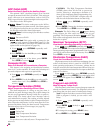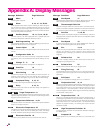
How the Sentry
Handles Power Failures
The Sentry handles a power failure in two ways:
1 After a brief power failure, the controller continues
firing as before. It shows a normal temperature dis
-
play alternating with PF .
2 After an extended power failure, PF 2 or PF 3 will
appear. The kiln will NOT resume firing.
The controller will resume the firing after a brief power
failure provided these conditions are met:
■
The temperature must be above 212°F/100°C when the
power comes back on.
■
A Ramp-Hold programmed with a rate of 108°F/60°C in
thefinal segment:if powerfailed inthe finalsegment, the
temperature dropped less than 72°F/40°C.
■
Cone-Fire: if power failed in the final segment, the tem
-
perature dropped less than 72°F/40°C.
When the Sentry aborts a firing after a power failure, the
display will show the following:
■
PF 2 or PF 3
■
Total firing time before power failed
■
Temperature at the time of power failure
■
Current kiln temperature
To resumefiring, pressENTER. Thekiln willbegin firing
again from its present temperature. For example, the kiln
reached 1000°F/538°C when power failed. The temperature
is800°F/426°C whenyou turnthe kilnback on.Firing willre-
sume from 800°F/426°C. You need not cool the kiln to room
temperature before starting a ceramic firing over unless you
decide to use new witness cones.
When you resume firing by pressing ENTER, the control
-
ler begins firing in the first segment with a temperature
higher than the current kiln temperature. However, if the
power failed during a ramping down (cooling) segment, the
controllerwill resumefiring fromthesame coolingsegment.
Using Ceramic Shelf Cones After an
Extended Power Failure
■
The firing was interrupted more than 100°F/56°C
from the terminal temperature: Firethe ware again.
It is okay to use the same partially fired witness cones,
even if they cooled back down to room temperature. So
longas theconesdid notheatto within100°F/56°C ofma
-
turity, they can be used again.
■
The firing was interrupted less than 100°F/56°C
from the terminal temperature: Firethe ware again.
If the kiln shuts off within 100°F/55°C of maturity, and
the temperature drops 50°F/28°C or more after the kiln
shuts off, do not depend on the witness cones. Once they
cool 50°F/28°C after they have been heated to within
100°F/55°C of maturity, they will not bend properly. This
is because they form a hard shell.
PLOG Error Codes
A PLOG error code means that the controller failed a
self-diagnostic test. A chattering, noisy relay, low voltage,
and the wrong relay type can cause a PLOG error. The con
-
troller will not operate while a PLOG message appears.
PLOG 3 / Memory Corruption
Resets the Sentry to factory default settings.
PLOG 4 / Configuration Corruption
Return the Sentry to the factory after a PLOG 4 code.
PLOG 5 / Firmware Problem
PLOG 6 / Software Problem
PLOG 7, 8, 9 / Non-Volatile Memory Problem
PLOG 10 / Program Storage Problem
PLOG 11 / Bad Thermocouple Signal for 60 seconds
Clearing a PLOG 11 Error Code
PLOG 11 indicates that a thermocouple is about to fail or
that electrical noise is affecting the thermocouple.
■
Try moving the thermocouple lead wires away from
nearby electrical wires and relays.
■
Make sure the bare part of the leads extending from the
thermocouple are not touching the kiln case.
■
Replacing the thermocouple usually clears the PLOG 11
code.
Clearing the Other PLOG Error Codes
■
Clear the PLOG error code by pressing ENTER.
■
If pressingENTER doesnot cleara PLOG error,turn off
power to the kiln for 10 seconds. Repeat if necessary.
Aftera PLOGerror clears,itis okaytofire thekiln again.
TCdE / Uneven Multiple
Zone Temperatures
On a multiple zone kiln, TCdE usually means the
thermocouples and elements are improperly wired. A ther
-
mocouple is turning on the elements to the wrong zone. For
instance, if the top thermocouple turns on the bottom ele
-
ments, thekiln will fireout ofbalance. When zonesare out of
balance by 140°F/60°C, TCdE will appear in the display.
Visually compare the wiring of the thermocouples, relays
and elements of your kiln to the kiln’s wiring diagram. Also,
use the Element Test option shown on page 21.
TCR / Thermocouple Leads Reversed
Check that the thermocouple lead wires are connected to
the correct terminals. See your wiring diagram.
23


















